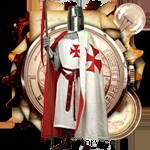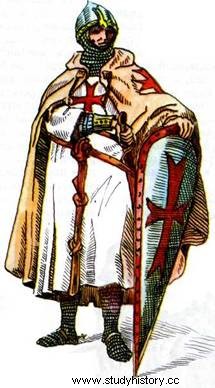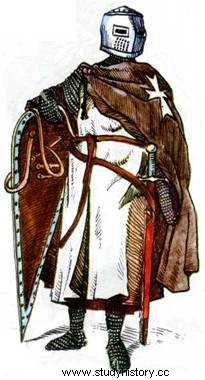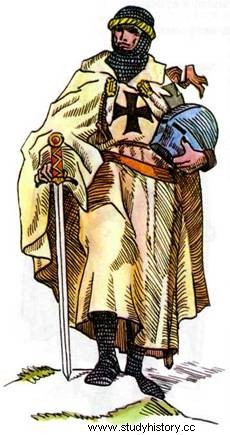 Knightly Orders in history are quite an interesting phenomenon. On the one hand, the stories about them are shrouded in romanticism and mysticism, and on the other, various kinds of atrocities and barbarism. It is known that from 1100 to 1300, 12 chivalric spiritual orders were formed in Europe, but three orders turned out to be the most viable and famous. These are the Order of the Knights Templar, the Hospitallers and the Teutonic Order. In this article, we will consider them in more detail and try to fill in the gaps in this topic.
Knightly Orders in history are quite an interesting phenomenon. On the one hand, the stories about them are shrouded in romanticism and mysticism, and on the other, various kinds of atrocities and barbarism. It is known that from 1100 to 1300, 12 chivalric spiritual orders were formed in Europe, but three orders turned out to be the most viable and famous. These are the Order of the Knights Templar, the Hospitallers and the Teutonic Order. In this article, we will consider them in more detail and try to fill in the gaps in this topic.

The Templar Order
Officially, this order was called the Secret Knighthood of Christ and the Temple of Solomon, but in Europe it was better known as the Order of the Knights of the Temple. His residence was in Jerusalem, on the site where, according to legend, the temple of King Solomon (tample - temple (French) was located. The knights themselves were called templars. The creation of the order was proclaimed in 1118-1119 by nine French knights, led by Hugo de Payns of Champagne. For nine years, these nine knights remained silent, not a single chronicler of that time mentions them. But in 1127 they returned to France and declared themselves. And in 1128, the church Cathedral in Troyes (Champagne) officially recognized the order.
The seal of the Templars depicted two knights riding the same horse, which was supposed to speak of poverty and brotherhood. The symbol of the order was a white cloak with a red eight-pointed cross.
It was the purpose of its members to "take care of roads and routes as much as possible, and especially the protection of pilgrims." The charter forbade any secular entertainment, laughter, singing, etc. The knights had to take three vows:chastity, poverty and obedience. The discipline was harsh:"Each does not follow his own will at all, but is more concerned about obeying the one who orders." The Order becomes an independent military unit, subordinate only to the Grand Master (he immediately proclaimed de Payns) and the Pope.
From the very beginning of their activity, the Templars have become very popular in Europe. Despite and at the same time thanks to the vow of poverty, the order begins to accumulate great wealth. Each enterer donated his fortune to the order free of charge. The order received large possessions as a gift from the French king, the English king, and noble lords. In 1130, the Templars already have possessions in France, England, Scotland, Flanders, Spain, Portugal, and by 1140 - in Italy, Austria, Germany, Hungary and the Holy Land. In addition, the templars not only guarded the pilgrims, but also considered it their direct duty to attack and rob trade caravans.
The Knights Templar by the 12th century. became owners of unheard-of wealth and owned not only lands, but also shipyards, ports, and had a powerful fleet. They lent money to impoverished monarchs and thus could influence state affairs. By the way, it was the Templars who were the first to introduce accounting documents and bank checks.
The Knights of the Temple encouraged the development of science, and it is not surprising that many technical achievements (for example, the compass) ended up in their hands in the first place. Skillful knight surgeons healed the wounded - this was one of the duties of the order.
In the 11th century. the Templars, as “the bravest and most experienced people in military affairs,” were granted the fortress of Gaza in the Holy Land. But arrogance brought a lot of harm to the "warriors of Christ" and was one of the reasons for the defeat of Christians in Palestine. In 1191, the collapsed walls of the last fortress of Saint-Jean-d'Acre defended by the Templars buried not only the templars and their Grand Master, but also the glory of the order as an invincible army. The Templars moved from Palestine, first to Cyprus, and then finally to Europe. Huge land holdings, powerful financial resources and the presence of knights of the order among high dignitaries forced the governments of Europe to reckon with the Templars and often resort to their help as arbitrators.
In the XIII century, when the Pope announced a crusade against heretics - the Cathars the Albigensians, the Templars, the backbone of the Catholic Church, almost openly came out on their side.
In their pride, the Templars imagined themselves to be omnipotent. In 1252, the English king Henry III, outraged by their behavior, threatened the templars with the confiscation of land holdings. To which the Grand Master replied:“As long as you do justice, you will rule. If you violate our rights, then it is unlikely that you will remain king. And it wasn't just a threat. The Order could do it! The Knights Templar were many powerful people in the kingdom, and the will of the overlord was less sacred than the oath of allegiance to the order.
In the 14th century. King of France Philip IV the Handsome decided to get rid of the obstinate order, which, for lack of business in the East, began to interfere, and very actively, in the state affairs of Europe. Philip did not want to be in the place of Henry of England. In addition, the king needed to solve his financial problems:he owed the Templars a lot of money, but he didn’t want to give them away at all.
Philip went for a trick. He asked to be accepted into the order. But the Grand Master Jean de Male politely but firmly refused him, realizing that the king wanted to take his place in the future. Then the Pope (who was placed on the throne by Philip) suggested that the Knights Templar unite with their eternal rivals - the Hospitallers. In such a case, the independence of the order would be lost. But the master refused again.
Then in 1307, Philip the Handsome ordered the secret arrest of all the Templars in the kingdom. They were accused of heresy, of serving the devil and of witchcraft. (This was due to the mysterious rites of initiation into the members of the order and the subsequent preservation of the secret of his deeds.)
The investigation has been going on for seven years. Under torture, the templars confessed to everything, but during a public trial they retracted their testimony. On March 18, 1314, the Grand Master de Male and the Prior of Normandy were burned at a slow fire. Before his death, the Grand Master cursed the King and the Pope:“Pope Clement! King Philip! In less than a year, I will call you to the judgment of God!” The curse came true:the Pope died two weeks later, and the king in the fall. Most likely they were poisoned by the templars, skilled in the manufacture of poisons.
Although Philip the Handsome failed to organize a persecution of the Templars throughout Europe, the former power of the Templars was undermined. The remnants of this order were never able to unite, although its symbols continued to be used. Christopher Columbus discovered America under the flag of the Templars:a white cloth with a red eight-pointed cross.
 Order of the Hospitallers
Order of the Hospitallers
The official name is the Order of the Equestrians of the Hospital of St. John of Jerusalem (gospitalis - guest (lat.); originally the word "hospital" meant "hospital home"). In 1070, a hospital for pilgrims to holy places was founded in Palestine by the merchant Mauro of Amalfi. Gradually, a brotherhood was formed there to care for the sick and wounded. It grew stronger, increased, began to have a fairly strong influence, and in 1113 it was officially recognized by the Pope as a spiritual and knightly order.
The knights took three vows:poverty, chastity, and obedience. The symbol of the order was an eight-pointed white cross. It was originally placed on the left shoulder of the black robe. The mantle had very narrow sleeves, which symbolized the monk's lack of freedom. Later, the knights began to wear a red robe with a cross sewn on the chest. There were three categories in the order:knights, chaplains and serving brethren. From 1155, the Grand Master, who was proclaimed Raymond de Puy, became the head of the order. The general chapter met to make the most important decisions. Members of the chapter gave the Grand Master a purse with eight denarii, which was supposed to symbolize the refusal of the knights from wealth.
Originally, the main task of the order was to care for the sick and wounded. The main hospital in Palestine had about 2,000 beds. The knights distributed gratuitous aid to the poor, arranged free meals for them three times a week. The Hospitallers had a shelter for foundlings and infants. For all the sick and wounded, there were the same conditions:clothes and food of the same quality, regardless of origin. From the middle of the XII century. the main duty of the knights is the war with the infidels and the protection of pilgrims. The order already has possessions in Palestine and southern France. The Ioannites begin, just like the Templars, to gain great influence in Europe.
At the end of the 12th century, when the Christians were driven out of Palestine, the St. Johnites settled in Cyprus. But this situation did not suit the knights. And in 1307, the Grand Master Falcon de Villaret led the Ioannites to storm the island of Rhodes. The local population, fearful of losing their independence, fiercely resisted. However, two years later, the knights finally fortified themselves on the island and created strong defensive structures there. Now the Hospitallers, or, as they began to be called, the "Rhodian knights", became the outpost of Christians in the East. In 1453, Constantinople fell - Asia Minor and Greece were completely in the hands of the Turks. The knights were expecting an attack on the oszhra. It was not slow to follow. In 1480, the Turks attacked the island of Rhodes. The knights survived and repulsed the attack. The Ioannites simply "an eyesore to the Sultan" with their presence at its very shores, making it difficult to manage in the Mediterranean Sea. Finally, the patience of the Turks was exhausted. In 1522, Sultan Suleiman the Magnificent swore to expel Christians from his dominions. The island of Rhodes was besieged by a 200,000-strong army on 700 ships. The Johnites held out for three months before Grand Master Villiers de Lille Adan surrendered his sword to the Sultan. The Sultan, respecting the courage of the opponents, released the knights and even helped them with the evacuation.
The Johannites had almost no land in Europe. And so the defenders of Christianity arrived at the shores of Europe, which they had defended for so long. The Holy Roman Emperor Charles V offered the Maltese archipelago to the Hospitallers. Henceforth, the Knights Hospitaller became known as the Order of the Knights of Malta. The Maltese continued their struggle with the Turks and sea pirates, since the order had its own fleet. In the 60s. 16th century Grand Master Jean de la Vallette, having at his disposal 600 knights and 7,000 soldiers, repelled an attack by a 35,000-strong army of selected Janissaries. The siege lasted four months:the knights lost 240 cavaliers and 5 thousand soldiers, but fought back.
In 1798, Bonaparte, setting off with an army to Egypt, stormed the island of Malta and expelled the Knights of Malta from there. Once again, the Johnites were homeless. This time they found shelter in Russia, whose emperor, Paul I, they proclaimed as a sign of gratitude the Grand Master. In 1800, the island of Malta was captured by the British, who were not going to return it to the Knights of Malta.
After the assassination of Paul I by conspirators, the St. Johnites had no Grand Master and no permanent headquarters. Finally, in 1871, Jean-Baptiste Cescia-Santa Croce was proclaimed Grand Master.
Earlier from 1262, in order to join the Order of the Hospitallers, one had to be of noble birth. Subsequently, there were two categories of those entering the order - knights by birthright (cavalieri di giustizzia) and by vocation (cavalieri di grazzia). The last category includes people who do not have to provide evidence of noble birth. It was enough for them to prove that their father and grandfather were not slaves and artisans. Monarchs who proved their loyalty to Christianity were also accepted into the order. Women could also be members of the Order of Malta. Grand masters were chosen only from knights of noble birth. The Grand Master was almost a sovereign sovereign, Fr. Malta. The symbols of his power were the crown, the "dagger of faith" - the sword and the seal. From the Pope, the Grand Master received the title of "guardian of the Jerusalem-Lim court" and "guardian of the army of Christ." The order itself was called the "Reigning Order of St. John of Jerusalem.
The knights had certain obligations to the order - they could not leave the barracks without the permission of the Grand Master, they spent a total of 5 years in the convention (dormitory, more precisely, the barracks of the knights) on about. Malta. The knights had to sail on the ships of the order for at least 2.5 years - this duty was called the "caravan".
By the middle of the 19th century. The Order of Malta is transformed from a military into a spiritual and charitable corporation, which it remains to this day. The residence of the Knights of Malta is now in Rome.
The Cross of the Order of Malta has served since the 18th century. one of the highest awards in Italy, Austria, Prussia, Spain and Russia. Under Paul I, it was called the cross of St. John of Jerusalem.
 The Teutonic Order
The Teutonic Order
In the 12th century. in Jerusalem there was a hospital (hospice) for German-speaking pilgrims. He became the predecessor of the Teutonic Order. Initially, the Teutons occupied a subordinate position in relation to the Order of the Hospitallers. But then in 1199 the Pope approved the charter of the order, and Heinrich Walpot was proclaimed Grand Master. However, only in 1221, all the privileges that other, older orders of the Templars and St. John had extended to the Teutons.
Knights of the order took vows of chastity, obedience, and poverty. Unlike other orders, whose knights were of different "languages" (nationalities), the Teutonic Order mainly consisted of German knights.
The symbols of the order were a white cloak and a simple black cross.
The Teutons very quickly abandoned their duties of guarding pilgrims and treating the wounded in Palestine. Any attempt by the Teutons to interfere in the affairs of the powerful Holy Roman Empire was thwarted. Fragmented Germany did not make it possible to turn around, as the Templars did in France and England. Therefore, the Order began to engage in "good activities" - to carry the word of Christ to the eastern lands with fire and sword, leaving others to fight for the tomb of the Lord. The lands that the knights conquered became their possession under the supreme power of the order. In 1198, the knights became the main striking force of the crusade against the Livs and conquered the Baltic states, at the beginning of the 13th century. founding the city of Riga. This is how the state of the Teutonic Order was formed. Further, in 1243, the knights conquered the Prussians and took away the northern lands from the Polish state.
There was another German order, the Livonian. In 1237, the Teutonic Order teamed up with him and decided to move on to conquer the northern Russian lands, expanding their borders and strengthening their influence. In 1240, the Order's allies, the Swedes, suffered a crushing defeat from Prince Alexander Yaroslavich on the Neva. And in 1242
the same fate befell the Teutons - about 500 knights died, and 50 were taken prisoner. The plan to annex Russian territory to the lands of the Teutonic Order has failed completely.
The Teutonic Grand Masters constantly feared the unification of Russia and tried to prevent it by any means. However, a powerful and dangerous enemy, the Polish-Lithuanian state, stood in their way. In 1409, a war broke out between him and the Teutonic Order. The combined forces in 1410 at the Battle of Grunwald defeated the Teutonic Knights. But the misfortunes of the Order did not end there. The Grand Master of the Order, like the Maltese, was a sovereign sovereign. In 1511, it was Albert Hohenzollern, who, being a "good Catholic", did not support the Reformation, which was fighting against the Catholic Church. And in 1525 he proclaimed himself secular sovereign of Prussia and Brandenburg and deprived the order of both possessions and privileges. After such a blow, the Teutons did not recover, and the order continued to drag out a miserable existence.
In the 20th century. German fascists extolled the former merits of the order and its ideology. They also used the symbols of the Teutons. Remember, the Iron Cross (a black cross on a white background) is an important award of the Third Reich. However, the members of the order themselves were persecuted, apparently, as having not justified their trust. The Teutonic Order exists in Germany to this day.
